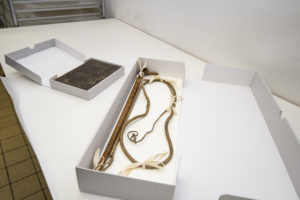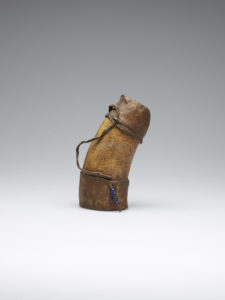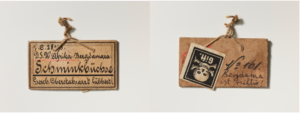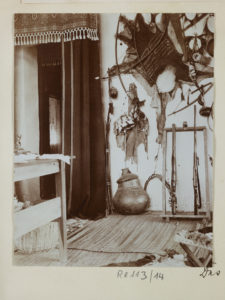A Contamination of Provenance?
The Relevance of Extended Materialities to Provenance Research and Restitution Processes. Examples from the Linden Museum Stuttgart

Figure 1: the whip and bible ascribed to Hendrik Witbooi once prepared for transport to Namibia (February 2019, Linden Museum, photograph: Dominik Drasdow).
In 2013, the Ministry of Sciences, Research and Art of Baden-Württemberg, in cooperation with the Linden Museum, initiated the process with Namibian counterparts that would lead to the restitution of the bible and whip ascribed to the Namibian national hero, Hendrik Witbooi. The restitution eventually took place in February 2019.[1] While this political event has received considerable attention in the national and international press, parallel background efforts to reconsider colonial museum collections have been less visible. Between 2016 and 2018, Gesa Grimme carried out provenance research on the Linden Museum’s Namibia collection, next to collections from Cameroon and the Bismarck-Archipelago.[2] Since late 2018, the museum continues this effort by employing two provenance researchers, including myself. These two positions are related to two initiatives. First, the Linden Museum is part of the initiative for ethnological museums created by the German Federal Cultural Foundation in 2018. Together with the MARKK in Hamburg and the Grassi Museum in Leipzig, the Linden Museum receives funding over the course of three years to support processes of renewal.[3] Secondly, the Linden Museum joined several other cultural institutions in Baden-Württemberg in the so-called “Namibia Initiative”, with the aim to establish ongoing relationships with their Namibian counterparts.[4] In this essay I address the role which a close attention to museum objects, the recognition of an extended materiality, and indeed past and present textual and photographic descriptions of objects may play in provenance research and consequently in restitution processes.
In February of this year, briefly before the bible and whip were returned to Namibia, considerable backstage activities took place around curatorial offices, the conservation department and the exhibition space at the Linden Museum. On one occasion, several members of staff looked on, while one of the conservators carefully placed the bible, and even more carefully, the fragile whip onto specially made carriers. To hold the whip’s lash into place, the conservator used multiple knotted strings to fix it to a sheet of archival acid-free cardboard (Figure 1). During the process, one colleague exclaimed that we were in fact privileged to witness a very special moment. But how was this moment extraordinary when compared to other tactile scenarios, in which these two objects had been previously involved, and would soon further experience? Detailed biographies of the objects prior to their entry into the museum’s collection have not been recorded, and even their moment of entry in June 1902 is only mentioned with a few lines in the accession books. However, in contrast to this lack of documentation, we experienced the exact moment when a meaningful exit, a renewed transition, was taking place. Indeed, participating in this tangible process of deaccessioning made us more aware of the moment’s significance.
Once the whip and the bible had arrived in Windhoek, Namibian authorities made the decision to accompany the heirlooms with two unidentified human skulls, which had been brought to Namibia from Germany during an earlier act of repatriation in 2018. The exact moment this decision was taken, and the moment this ensemble was created, remain unclear. Nevertheless, as a conscious and purposeful act, the ensemble constituted a powerful compound with its own agency. As the director of the Linden Museum, Inés de Castro, confirmed as a member of the German delegation, the proclaimed authenticity of these objects had a considerable emotional impact on people in Namibia. Compounding different registers of materiality and symbolism thus developed a surplus power, which the two artifacts from Stuttgart could have hardly achieved on their own.
Processes of restitution involving the collections of former “ethnological” museums have so far been debated foremost according to ethical, historical, and political viewpoints. Inherently material conditions of to-be-restituted objects often merely serve to determine provenance and have a low visibility in the current European media debate, despite the fact that they necessarily underpin and constitute processes of restitution. The notion of an extended materiality museum objects may, next to the dimensions I just described, include descriptive labels, histories of treatment with pesticides, histories of being photographed, as well as the very material basis for the reconstruction of provenance: their inscription into accession registers. While it may initially appear as a contamination of provenance, reassembling the seemingly peripheral dimensions of materiality that cluster around museum objects throughout their biographies can provide a clearer perspective on restitution processes. I hope to further illustrate this with first examples of my research-in-progress at the Linden Museum Stuttgart.

Figure 2: object 028198, “Schminkbüchse”, 23 x 9 cm (Linden Museum, photograph: Dominik Drasdow).
In January 1903, Oberstabsarzt [5] Anton Lübbert donated 271 objects to the Linden Museum.[6] According to his correspondence with the museum’s main curator, Karl Graf von Linden, he had personally acquired most of these items during his time in Namibia between 1897 and 1902. The correspondence further suggests that he also acquired objects through middlemen, such as farmers and traders.[7] Several of the issues mentioned in the previous paragraph coalesce in the case of one particular example from the donated collection (Figure 2). What Lübbert described as a “container for cosmetics [Schminkbüchse]”, bears several traces that allow us to reassemble an extended materiality. Very similar objects can be found in most German museum collections from Namibia: they consist of a main body of bovine horn, cut at both ends, each end sealed with a leather cap. One of these caps serves as a lid, attached with a short string to the main body. The bottom end in this particular case is decorated with another short string holding four blue beads. This particular container is completely empty and bears no residues of any former content.

Figure 3: front and verso of the label formerly attached to object 028198, 4 x 2,1 cm (Linden Museum, photographs: Dominik Drasdow).
On entering the collection of the Linden Museum prior to the First World War, every object was given a label bearing information the curators deemed important (Figure 3). The label’s front usually contains an accession number (28198), the country of origin (D.S.W. Afrika [German South West Africa]), an ethnic denomination (Bergdamara), a general object description (Schminkbüchse), the mode of transaction (Geschenk [gift]), and finally the donor’s title, rank, or profession (Oberstabsarzt) and surname (Lübbert). Probably at the same time, the curator used Indian ink to inscribe the inventory number, the ethnic denomination, and the name of the donor directly onto every individual part of the object. As most of the objects were on display, it was crucially important to Von Linden, as well as to the donors themselves, that the donor of each object was prominently identified by name. In fact, by being displayed in public in this way the objects guaranteed the donor’s social prestige. Over the years, however, one way or another, some labels were separated from their objects: strings loosened and some labels came off. Also, later generations of curators during the 20th century occasionally separated objects and labels when they put an object on display. It is likely that—in one way or another—curators perceived the information as distracting from the object. It remains unclear, however, whether they considered the employed terminologies as unwelcome reminders of a colonial past, or even an affront to both the objects themselves and the former owners, and thus a “contamination” of the exhibition space. In any case, a rather large collection of labels is today stored in the museum’s depot, detached from their objects. Reconnecting such severed traces is important, as they constitute spaces of intervention and description that have not been recorded in any other form.
The Linden Museum’s accession register refers to objects similar to the one under discussion variously as “Fettdose”, “Giftbehälter”, or “Pulverhorn”, often depending on the collectors’ own associations. Collectors transposed subjective frames of reference and familiarity with similar objects at home. The register thus ascribes very similar objects manufactured after this principal with different functions as containers for either fat, poison, or powder, and eventually also relates them to very different ethnicities: “Bergdamara”, “Herero”, “Khoi-Khoin”, and “San”. However, we realise today that historical descriptive and ethnic denominations can never be based only on an object’s appearance and its similarity to other objects. It is even possible that the very same object was circulated or traded amongst users of different ethnic identities, as well as used for different purposes over time.
The verso of the label originally attached to the container collected by Lübbert, further points to three backstage interventions preceding and succeeding the object’s entry into the collection: a glued-on sticker bearing a skull and crossbones with the warning: “Gift [poison]” (we will turn to this trace in a moment); a number (No. 161) adapted from an earlier accessioning list provided by the ethnographic museum of Berlin; and the written intervention of a later curator at the Linden Museum regarding the ethnic denomination: “Bergdama ist richtig! [Bergdama is correct]”. Felix von Luschan in Berlin, through his privilege of having the first pick of collections from German colonies according to the so-called “Bunderatsbeschluss”[8], had made a selection from Lübbert’s even larger original collection. The collection at the Linden Museum is thus a fusion of actions and ideas by Von Luschan and Lübbert: it neatly divided objects as originating from “Herero”, “Ovambo”, “Buschmänner”, and “Bergdamara” communities. Von Linden in Stuttgart generally applied the denominations provided to him, sometimes cross-checking them with the atlases available in his library. A curator in Stuttgart of a later generation eventually corrected the spelling of one such identity, but nevertheless reconfirmed it (“Bergdama ist richtig!”). Shifts in the spelling of ethnic names, such as from “Bergdamara” to “Bergdama”, were for example systematised by George Peter Murdock, who established a commonly used register of “peoples” during the 1950s.[9] This register certified an encyclopedic approach to the classification of objects for some time to come.

Figure 4: uncatalogued photograph showing parts of the residence of the Bezirkschef Viktor von Frankenberg at Schuckmannsburg (today Luhonono) in the Caprivi Strip, approx. 1911-1914 (photographer unknown, Linden Museum, reproduction: Dominik Drasdow).
The potential arbitrariness of ascriptions to objects as we encounter them in published and archival documents is often based on the collector’s individual relationship to the objects and the people who made them. Collecting and decorating with “ethnographic” objects was a pastime for many colonial administrators and militaries, and in particular for those who had to hold out in remote areas for prolonged periods. A growing number of studies [10] suggests that several members of the German military and South African police both established and photographed their residencies as an arrangement of imported goods of European “material culture”. The Bezirkschef at Schuckmannsburg, Viktor von Frankenberg, even contrasted his interior with those local objects he had collected (Figure 4). It was also not uncommon that former colonial staff decorated their private spaces with such objects once they had returned home. While they were on duty, collecting objects may have indeed helped to pass time, or even as an attempt to better understand and control their temporary lifeworld. Contacts to the scientific community in Europe were sometimes only established once these collections already existed. A second level of commemoration is illustrated by the practice to document such private spaces photographically, such as in the above example by Von Frankenberg. He decorated one of his walls with several items he would have acquired locally: skins of game, body adornments, small containers of various sorts, weapons such as bows and arrows, all notably next to his own two rifles. In any case, such a photograph can only provide us with the historical “anteroom” of collecting [11], and not with the moment of collecting as such. Often, higher-ranking colonial administrators even relied on others to collect for them, and thus were not always fully aware of the exact origins of their possessions.
Once collectors had returned to their home country, such objects and photographs often served as memorabilia. However, under particular circumstances, some former colonial administrators or militaries eventually let go of their collections, for example due to lack of funds or space.[12] When, for example, Oberleutnant Kurt Freiherr Treusch von Buttlar-Brandenfels moved house in 1907, he offered a collection of 19 objects to Von Linden. He mentioned that the “collection in question had served as wall decoration of [his] former flat” in Dresden, but was no longer suitable for his new flat in Berlin.[13] The solution to this conundrum was to donate the objects to an ethnographic museum. This furthermore allowed Von Buttlar-Brandenfels to gain social prestige in two ways: on the one hand, he had “his” collection exhibited publicly along with his name; on the other hand, Von Linden was known for his capacity to arrange for decorations in exchange for ethnographic collections.[14]
In fact, there was a close connection between social prestige and provenance, in particular once objects functioned as trophies of war. This was explicitly the case with Hendrik Witbooi’s bible and whip, donated to the Linden Museum in 1902. The donor, Paul Wassmannsdorf, was only able to identify their provenance because the two objects had earlier been singled out and circulated as the erstwhile possessions of a widely known colonial subject, who had been temporarily defeated by German troops in 1893. Objects looted during the violent attack on Witbooi’s residence Hornkranz must have circulated widely in colonial Berlin. For example, one of Witbooi’s hats and a pair of trousers were displayed on the walls of the local Kolonialheim.[15] The explicit treatment of objects as trophies was also the case with the collection donated by Von Buttlar-Brandenfels. He repeatedly tried to raise interest for his collection by arguing for its heightened “historical” value through the fact that it was possible to connect it to particular battles of the German-Herero War in 1904; a point that Von Linden responded to in full agreement. Von Buttlar-Brandenfels thus located objects in a particular time and space, and most importantly connected them to their original owners. For example, the narrative of Von Buttlar-Brandenfels connects a necklace, currently exhibited in the Linden Museum’s Africa exhibition, to a historical human body in a most visceral way:
1 necklace, made from segments of ostrich egg shell, taken from [abgenommen] a woman, which has been killed by a grenade during the battle of Otjihinamaparero on 25. February 1904.[16]
Von Buttlar-Brandenfels was personally present during this battle as an adjutant to Major Ludwig von Estorff, and also likely to have been the one who took the objects. Nevertheless, he only uses the passive voice to describe the actions carried out in relation to objects and people’s bodies. Selecting and collecting objects while looting was a precondition to the creation of trophies. It was the act of writing, the practice of creating literary narratives in correspondence, however, which purposefully established objects as both “valuable” and “ethnographic”. In fact, this narrative purposefully established the object’s provenance, or its pedigree, if you so will. Interestingly, the very same logic of narratively creating “valuable” object biographies is still applied today in the economy of collecting “primitive art”.
I close this essay by briefly addressing yet another material condition indicated by the skull with crossbones on the back of the label previously attached to Lübbert’s donation. Museum workers treated objects liberally with pesticides since the late 1800s, and at least until the 1980s. In many German museums, research on the exact kind and degree of contamination is in dire need of more support in terms of money and manpower, as the tests required are both costly and time-consuming. For this reason, the Linden Museum’s conservation department equipped the German delegation to Namibia with a written statement, warning about the possibility that whip and bible are likely in a state of contamination.
Attention to the extended historical material culture of colonial interactions between object producers and collectors thus proves to be crucial, as much as it is crucial for today’s interactions relating to the very same objects. The fact that many collections have been treated with pesticides until a few decades ago makes collections even more sensitive: object biographies thus not only point to ambivalent colonial pasts, but also to complex futures. The inscriptions of ethnicity, donor, and mode of transaction on labels and objects mark them as inherent products of colonial circulation. This requires to think about what kinds of objects we are dealing with historically (eg. “trophies”?, “art”?, “ritual objects”?, “everyday objects”?), how the perceptions of these objects changed, and how they are still changing today. Also the political constitution and requirements of people in the countries of origin and the countries of storage have changed. These ongoing changes need to be addressed accordingly.
Pesticide contamination and colonial inscriptions are only two examples of an extended materiality, which may complicate the re-circulation in the form of restitution, and even the visits of stakeholders to museums. It is therefore essential for all partners to negotiate the extended object materialities I just discussed, as well as an object’s entire biography, even beyond what is currently understood as provenance research. It is limiting to perceive provenance research only as a tool to identify specific object origins in colonial contexts of violence and looting. Rather, broadening the conception of provenance research beyond the obviously colonial, and including peripheral biographical episodes, as well as their potential futures, allows for the renewed introduction of objects into social use. During the following years—thanks to projects such as the Namibia Initiative—staff of the Linden Museum will have the opportunity to collaboratively explore the depth of the legacies of colonial collecting together with colleagues and partners based in other countries. It is only such approaches to research that enable processes such as deaccessioning, decontamination, and decolonisation. However, while processes such as these may be currently desired in museum practice, I hope to have shown that they are not as straightforward as one may think.
______________________
[1] For a limited history of the process and the political difficulties it caused, see Kössler (2019). The process and its preparation has also been covered widely in the German press.
[2] Grimme (2018).
[3] https://www.kulturstiftung-des-bundes.de/de/projekte/bild_und_raum/detail/initiative_fuer_ethnologische_sammlungen.html. (last accessed 25. June 2019).
[4] https://mwk.baden-wuerttemberg.de/de/service/presse/pressemitteilung/pid/namibia-initiative-des-landes-1/. (last accessed 25. June 2019).
[5] I choose not to translate colonial German ranks and titles as they may have no exact equivalent in the English language.
Collections acquired by Lübbert are also present in Berlin, Freiburg, and Leipzig, and will hopefully be studied further in conjunction. As Lübbert also collected human remains, this would not only allow retracing collection networks, but also to better understand the connections between different kinds of collections.
[7] Correspondence File Linden Museum Lübbert: Lübbert to Von Linden, 15.09.1904.
[8] Hoffmann (2010).
[9] Cf. Murdock (1959:53); also see Forkl (2007).
[10] Rizzo (2007), Peters (2018), also see Weissköppel (2018).
[11] Freely adapted from Kracauer’s “anteroom” of history (1995 [1969]).
[12] For a general overview of the Namibia collection of the Linden Museum and the provenance research conducted so far see Grimme (2018).
[13] My own translation from the German original: Correspondence File Linden Museum Buttlar-Brandenfels: Buttlar-Brandenfels to Von Linden, 05.09.1907.
[14] In particular the royal Friedrichs-Orden of Württemberg. Cf. Himmelsbach (forthcoming).
[15] A social club for men interested in colonial activities (cf. Heffe 1901:35).
[16] My own translation from the German original: Correspondence File Linden Museum, Buttlar-Brandenfels: accession list provided by Buttlar-Brandenfels, September 1907.
Bibliography
Forkl, Hermann and Monika Firla-Forkl. 2007. Von Kapstadt bis Windhuk: “Hottentotten” oder Khoekhoen: die Rehabilitierung einer Völkergruppe. Stuttgart: Linden-Museum.
Grimme, Gesa. 2018. Provenienzforschung im Projekt “Schwieriges Erbe: Zum Umgang mit Kolonialzeitlichen Objekten in Ethnologischen Museen” (Abschlussbericht). LINK
(last accessed 25. June 2019).
Heffe, H. 1901. “Das Neue Kolonialheim der Abteilung Berlin”. Deutsche Kolonialzeitung 18(4), 24. Januar 1901. 33-36.
Himmelsbach, Markus. Forthcoming. “Briefe aus der ‘Mitte der Massai-Steppe’, ‘Praktische Ehrungen’ und der ‘Berliner Moloch’ – Einblicke in das Sammlernetzwerk des Karl Graf von Linden”. Tribus. Band 68.
Hoffmann, Beatrix. 2012. Das Museumsobjekt als Tausch- und Handelsgegenstand: Zum Bedeutungswandel Musealer Objekte im Kontext der Veräußerungen aus dem Sammlungsbestand des Museums für Völkerkunde Berlin. Berlin: LIT Verlag.
Kössler, Reinhart. 2019. “The Bible and the Whip – Entanglements surrounding the Restitution of looted heirlooms”. Arnold Bergstraesser Institute Working Papers. No. 12.
Kracauer, Siegfried. 1995 [1969]. History, the Last Things Before the Last. (Ed.) Paul O. Kristeller. Princeton: Markus Wiener Publishers.
Murdock, George P. 1959. Africa: Its Peoples and their Cultural History. New York: McGraw-Hill Book Company.
Peters, Ulrike 2018. Concept Statement. In: (Ed. Johanna Wild) Ovizire Somgu: From Where do We Speak? Woher Sprechen Wir? Hamburg: MARKK. 48-57.
Rizzo, Lorena 2013. “Between the Book and the Lamp: Interiors of Bureaucracy and the Materiality of Colonial Power.” African Historical Review 45, no. 2: 31-51.
Weißköppel, Cordula. 2018. Ovizire Somgu: Von woher sprechen wir? https://boasblogs.org/de/dcntr/ovizire-somgu-von-woher-sprechen-wir/.
(Last accessed 24. June 2019).































